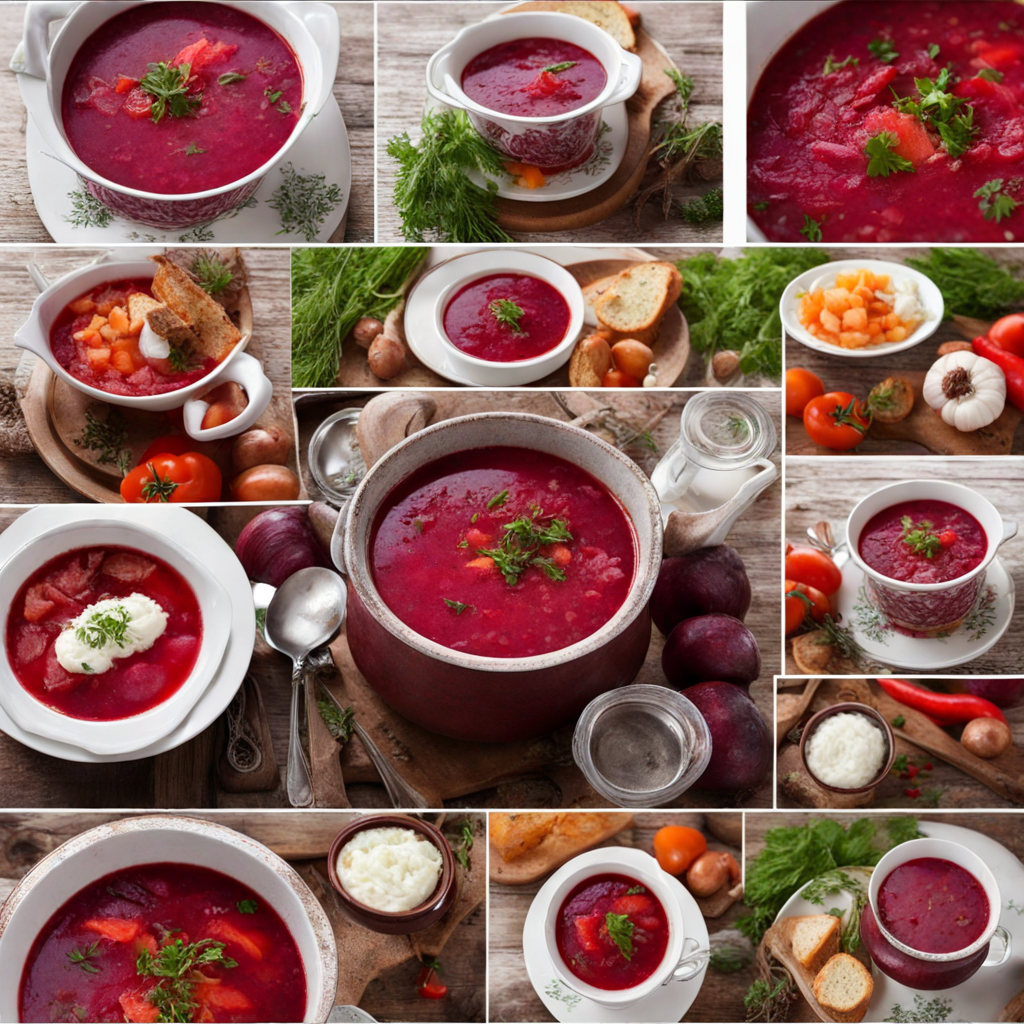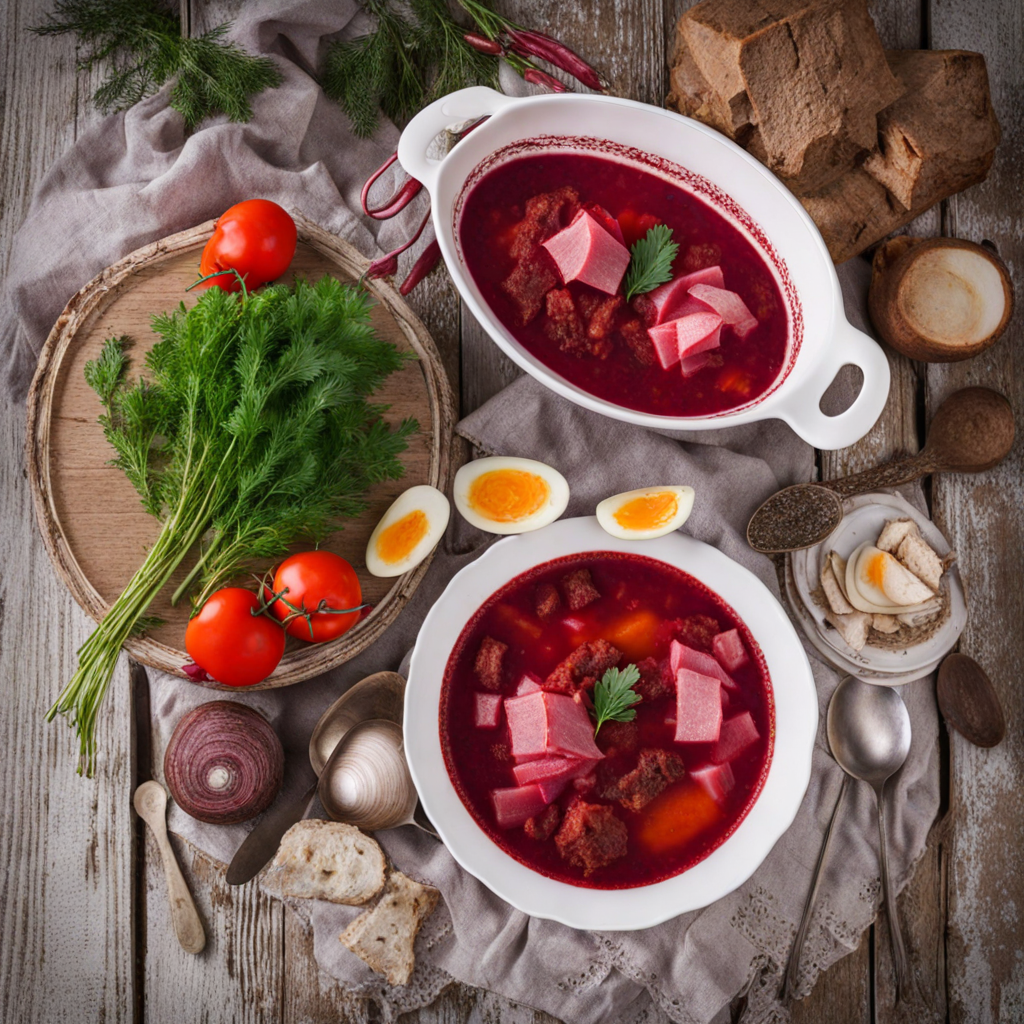Belarusian Borscht
Belarusian Borscht is a vibrant and hearty soup that embodies the rich culinary traditions of Belarus. Unlike its Ukrainian counterpart, this version often features a unique blend of beets, which give the dish its signature deep red color, combined with a multitude of vegetables such as cabbage, carrots, and potatoes. The earthy sweetness of the beets harmonizes beautifully with the tanginess of vinegar, creating a complex flavor profile that warms the soul. Traditionally, this borscht is made with a meat stock, frequently using beef or pork, which adds depth and richness to the dish, while a sprinkle of fresh herbs like dill or parsley brightens each bowl. The preparation of Belarusian Borscht is a labor of love, starting with the sautéing of onions and garlic to build a fragrant base. As the vegetables soften and caramelize, the beets are added, allowing their vibrant color and flavor to infuse the broth. The soup is then simmered until all the ingredients meld together, resulting in a comforting dish that is perfect for chilly evenings. Often served with a dollop of sour cream on top, this borscht not only enhances the taste but also adds a creamy texture that complements the soup's rustic nature. What makes Belarusian Borscht truly special is its versatility and the way it reflects the seasons. In summer, fresh seasonal vegetables can be incorporated, while in winter, root vegetables provide hearty sustenance. Each family may have its own cherished recipe, passed down through generations, making every bowl a unique representation of Belarusian culture. Whether enjoyed as a main course or a starter, this borscht is a culinary journey through the heart of Belarus, inviting food lovers to explore its rich flavors and comforting warmth.
How It Became This Dish
The Story of Беларусскі боршч: A Culinary Treasure of Belarus Belarus, a landlocked country in Eastern Europe, is known for its rich cultural tapestry woven from centuries of history, tradition, and resilience. One of the most emblematic dishes of Belarusian cuisine is боршч, a vibrant beet soup that embodies the flavors, colors, and agricultural bounty of the region. Often referred to as Беларускі боршч (Belarusian borscht), this dish has a storied past and holds significant cultural importance, reflecting the identity and heritage of the Belarusian people. #### Origins: The Roots of Borscht The origins of borscht can be traced back to the Slavic peoples in Eastern Europe, with many claiming its birthplace to be Ukraine or Russia. However, the use of beets as a primary ingredient can be found in various forms across Eastern European cuisines. The word "borsch" is believed to derive from the Old Slavic term for "cow parsnip," a wild plant once used in the soup's early iterations. The first documented recipes of borscht appear in the 16th century, but the dish likely predates written records. In Belarus, the use of beets is not merely a culinary choice; it reflects the agricultural practices and the climatic conditions of the region. Beets thrive in the cool, temperate climate of Belarus, making them a staple in the local diet. The dish evolved as a way for families to utilize the ingredients available to them, resulting in numerous regional variations. While Ukrainian borscht is often associated with meat and a rich flavor profile, Belarusian borscht is typically lighter and can be vegetarian, showcasing the versatility of beets. #### Cultural Significance: A Symbol of Community and Tradition In Belarus, боршч is more than just a dish; it is a cultural symbol that brings people together. Traditionally, it has been served during family gatherings, festive occasions, and communal meals. The soup is often prepared in large pots, making it ideal for sharing among family and friends. Its vibrant red color is emblematic of the warmth and hospitality of the Belarusian spirit. The preparation of белорусскі боршч is often a communal activity, with family members gathering in the kitchen to chop, stir, and taste. Recipes are frequently handed down through generations, each adding their personal touch to the dish. This practice not only preserves culinary traditions but also strengthens familial bonds and creates a sense of belonging. Moreover, боршч has a deep connection to Belarusian folklore and customs. It is often served during important life events, such as weddings and funerals, signifying its role in marking the passage of time and life’s milestones. In some regions, it is believed that the preparation of borscht can ward off misfortune, further underscoring its cultural significance. #### Evolution Over Time: From Peasant Food to Culinary Delight Historically, боршч was considered a peasant dish, utilizing simple, locally sourced ingredients. The basic version typically comprised beets, potatoes, carrots, onions, and cabbage, all simmered to create a hearty, nutritious meal. However, as Belarusian society evolved through the centuries, so too did the dish. During the Soviet era, traditional foods like боршч became standardized, and recipes were adapted to fit the availability of ingredients across the vast union. As a result, Belarusian borscht saw the introduction of meats, particularly pork or beef, elevating the dish’s status in the culinary hierarchy. The inclusion of sour cream as a garnish became a defining characteristic, adding creaminess and tanginess to the vibrant soup. With the fall of the Soviet Union in the early 1990s, there was a resurgence of interest in regional and traditional cuisines. Chefs began to explore the roots of Belarusian culinary traditions, experimenting with flavors and presentations while honoring the essence of classic dishes. This renaissance led to a revival of белорусскі боршч, with chefs showcasing it in modern restaurants, bringing a new audience to appreciate its historical and cultural significance. #### Contemporary Interpretations and Globalization In the contemporary culinary scene, белорусскі боршч has undergone numerous reinterpretations, often incorporating international influences while maintaining its core identity. Chefs experiment with different types of beets, including golden and striped varieties, and introduce elements such as smoked meats, fresh herbs, or spices to create a fusion of flavors. Some versions feature a more refined presentation, served in elegant bowls with artistic garnishes, while others embrace rustic styles that pay homage to traditional home cooking. Globalization has also played a role in the dissemination of Belarusian cuisine. With the rise of interest in Eastern European foods, боршч has found its way onto menus around the world. Food bloggers, chefs, and enthusiasts have shared their takes on the dish, introducing it to new audiences and fostering a greater understanding of Belarusian culture. This worldwide interest has sparked dialogues about culinary heritage, encouraging chefs to explore local ingredients and traditional methods. #### Conclusion: A Dish That Unites Belarusian боршч is a testament to the resilience and adaptability of a culture that has weathered centuries of change. From its humble origins as a peasant dish to its celebration in contemporary gastronomy, this iconic soup continues to serve as a symbol of community, tradition, and identity for the Belarusian people. Each bowl of бorscht tells a story—a story of the land, the people, and the culinary practices that have shaped a nation. As we savor the rich, earthy flavors of белорусскі боршч, we are not merely enjoying a dish; we are partaking in a tradition that spans generations, a reminder of the importance of food in connecting us to our roots and to one another. Whether enjoyed in a cozy Belarusian kitchen or a trendy restaurant halfway across the globe, боршч remains a vibrant celebration of Belarusian culture, reflecting the heart and soul of a nation that continues to thrive.
You may like
Discover local flavors from Belarus







